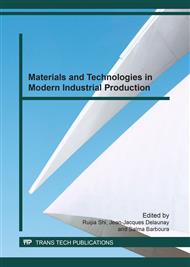p.22
p.27
p.32
p.36
p.42
p.47
p.51
p.56
p.60
Separation of Methane from Shuttle Tanker Vents Gases by Adsorption on a Polyurethane/Zeolite Membrane
Abstract:
Shuttle tankers are becoming more widely used in deep water installations as a means of transporting crude oil to storage plants and refineries. The emissions of hydrocarbon vapours arise mainly during loading and offloading operations. Experiments have been carried out on the use of polyurethane/zeolite membrane on an alumina support for the separation of methane from carbon dioxide and oxygen. The physical properties of the membrane were investigated by FTIR. Single gas permeation tests with methane, propane, oxygen and carbon dioxide at a temperature of 293 K and pressure ranging from 0.1 to 1.0 x 10-5 Pa were carried out. The molar flux of the gases through the membrane was in the range of 3 x 10-2 to 1 x 10-1 molm-2s-1. The highest separation factor of CH4/CO2 and CH4/O2 and CH4/C3H8 was determined to be 1.7, 1.7 and 1.6 respectively.
Info:
Periodical:
Pages:
42-46
Citation:
Online since:
March 2017
Authors:
Price:
Сopyright:
© 2017 Trans Tech Publications Ltd. All Rights Reserved
Share:
Citation:



